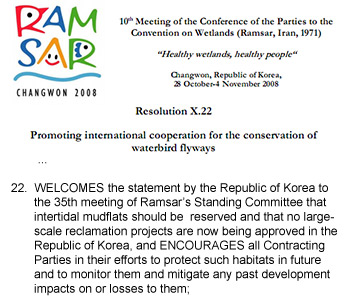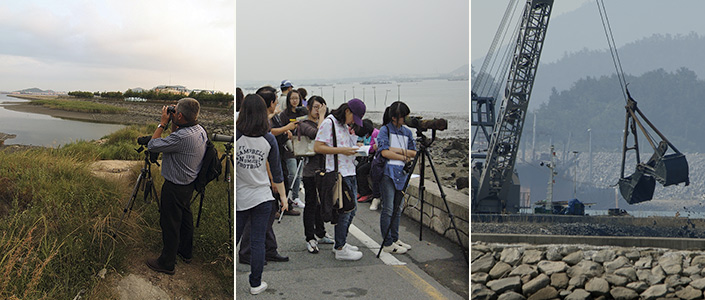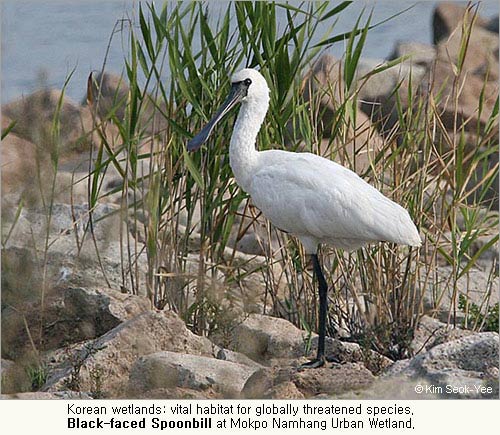It is now a year since Changwon City hosted the Tenth Ramsar “Wise Use of Wetlands” Convention Conference of the Parties (Ramsar COP 10).
Wetlands - tidal-flats, marshes, rivers, even reservoirs and rice-fields - are the most important habitat in the Republic of Korea for globally important bird biodiversity. The majority of globally threatened bird species in Korea depend on wetlands; and the largest concentrations of birds are also found at wetlands, making a few such places extremely popular with people at weekends or during special Bird Festivals.
Understanding of wetlands, and of the waterbirds that migrate to and from them each year, continues to increase year by year. This understanding has helped public attitudes towards conservation become more and more positive. Illegal hunting of waterbirds, uncommon a decade ago, appears to be even less widespread now, and according to Professor Hwang Ah-Ran of Pusan National University, 80% of all people when answering a recent poll supported the statement that "In planning development projects, environmental conservation should take precedence over economic gains". (see Korea Herald).
There is clearly broad popular support for conservation of wetlands and for genuinely sustainable development of the type as defined clearly in the Millennium Development Goals.

In the run-up to and also during Ramsar COP10 (October 28th-November 4th, 2008) positive media coverage of wetlands and waterbirds further increased this popular awareness and support for conservation. Three additional Ramsar sites were designated (taking the national total to eleven), and plans to develop a Regional Ramsar Centre for East Asia also evolved, becoming more fully realised this year.
At the Ramsar COP 10 itself, solid progress was also made. Ramsar is an intergovernmental convention and the decisions of the convention are expressed through Resolutions, agreed to by all member nations. There was unanimous support for example for Resolution X.22 ( that included “the statement by the Republic of Korea… that intertidal mudflats should be preserved and that no large-scale reclamation projects are now being approved in the Republic of Korea”); for Resolution X.27, calling for all nations to review the state of their urban wetlands and to put in place schemes for their restoration and rehabilitation as needed, and to formulate their land-use planning and management in such a way as to minimize any future impacts on urban wetlands; and for Resolution X.03 (“The Changwon Declaration on Human well-being and Wetlands” ).
The Changwon Declaration targets decision-makers, and clarifies why wetlands need to be conserved. It calls for:
“Decision-makers to stop our wetlands from becoming degraded or lost”;
“Decision-makers to restore our wetlands that are already degraded - this offers us an efficient and cost-effective means of increasing ground and surface water storage, improving water quality, sustaining agriculture and fisheries, and protecting biodiversity”;
“Decision-making [that] should, wherever possible, give priority to safeguarding naturally functioning wetlands and the benefits they provide.”
A year on from Ramsar COP 10 how much progress has been made by decision-makers towards reaching the agreed ideals of the Changwon Declaration?
A review of the Ramsar List reveals that since the Ramsar COP10 no new Ramsar sites have been designated in the Republic of Korea. We therefore still have only 11 Ramsar sites nationwide, totalling a mere 8,215 ha - a little over one fifth the area of the massively destructive Saemangeum reclamation project, and less than twice the area of the reclamation undertaken for the Incheon Free Economic Zone.
At present, we rank only 49th on the Ramsar list in terms of the number of Ramsar sites designated. Both China and Japan have 37, while previous Ramsar COP nations include Australia (with 65 Ramsar sites) and Spain (with 63). Worse still we are presently a dismal 130th out of 159 member nations in terms of actual area of Ramsar site (measured in hectares) - a rank almost unchanged since 2007.
Why is this? There is abundant recent talk about the merits of Green Finance and Green Growth, and after decades of hard work and self-sacrifice, the Republic of Korea already lies between 24th and 30th in the World Bank’s 2008 global ranking of GDP (i.e. we are a rich nation financially). As a nation we can afford to set up and maintain protected areas and Ramsar sites, and to fund management plans and even compensation schemes where needed. It is clearly not a lack of money that is preventing progress.
It is also not because of the size of national territory. Portugal, for example, is similar in land area (as well as economic rank) to the Republic of Korea, yet it has almost three times as many Ramsar sites covering an area that is more than ten times larger - 86,581 hectares.
Furthermore, the lack of Ramsar site designation is also clearly not because there are too few wetlands here that meet the Ramsar criteria. Probably twenty or more wetlands nationwide that are already well-known as internationally important for waterbirds still remain unlisted, including Joonam Reservoir in Changwon, the Geum Estuary, Namyang Bay (Hwaseong), Yeonjong tidal-flats, the Nakdong Estuary (now threatened further by a Busan City plan to repeal half of the estuary’s protected status), Song Do tidal-flats, and the Seosan reclamation lakes and rice-fields, as well of course as Saemangeum.
These wetlands have been surveyed numerous times, with annual counts of e.g. wintering waterbirds, and for some areas counts of migratory shorebirds, published by the Ministry of Environment - the national administrative authority for the Ramsar Convention.
In addition to these better known sites, there are a large number of other wetlands that are representative of a type, and are also important for biodiversity and for natural ecosystem services. As such they also are suitable for designation as Ramsar sites.
These include the Mokpo Namhang Urban Wetland, a small wetland of 50ha that on occasion supports globally threatened species (Saunders’s Gull Larus saundersi and Black-faced Spoonbill Platelea minor for example [see Birds Korea’ Bird News]) and also has a proven track record for environmental education. The Ramsar Resolution on urban wetlands (X.27) should help to support the conservation of the Mokpo Namhang Urban Wetland, yet the local office of the Ministry of Land, Transport and Maritime Affairs (MLTM) recently released their plan to infill much of the wetland there in 2010, to construct some houses, offices and some “park space”.

How is this proposed development at Mokpo “sustainable” when it requires the destruction of an urban wetland, a decline in wetland biodiversity, and a loss of other wetland services and benefits? Even while Birds Korea works towards an alternative proposal (one based on wetland conservation, restoration, community pride and environmental education), wetland-infilling is taking place. Up to now, all requests to MLTM to conserve the site have simply been rejected.
In Incheon City too, the remaining tidal-flats at Song Do, another urban wetland, also look set to be “reclaimed”. According to Birds Korea survey data, the Song Do tidal-flats support at least 13 species of waterbird in Ramsar-defined internationally important concentrations. As well as being one of the nation’s most important sites for shorebirds, it holds both breeding Saunders’s Gull and breeding Black-faced Spoonbill, one of very few such sites in the world.
The initial approval to reclaim the remaining area of tidal-flat as part of the Incheon Free Economic Zone (IFEZ) was given in March 2009 - a mere five months after the passing of Resolution X.22 praising the nation for giving up tidal-flat reclamation!
The more detailed Incheon City plan will be released in October 2009, with reclamation slated to start in 2010. Any further loss of habitat there will inevitably lead to a further decline in the species dependent upon inter-tidal habitat. Again an evolving alternative vision is available and is being offered to decision-makers, this time by SAVE International in collaboration with other organisations. Is it not reasonable to ask: How does reclamation (past and present) of the Song Do tidal-flats reconcile with the words spoken at Ramsar? Or with the aims of the new Green Growth Strategy? Or with efforts to promote Song Do as an award-winning Eco-city?
Even if not yet designated as Ramsar sites, decision-makers at all levels have pledged publicly to conserve such important wetlands, and to manage them wisely as part of national and global sustainable development.
Why then do almost all of our nation’s wetlands, including in some cases Ramsar sites and other protected areas, remain imminently threatened by reclamation or infrastructure development? By dredging, dams, dykes, roads, bicycle lanes and perhaps even now by “entirely eco-friendly” railway lines (POSCO press release, October 2, 2009), as recently proposed for Suncheon Bay, designated as a Ramsar site in 2006.
Threats are not confined to inter-tidal or urban wetlands of course. The massive reclamation lakes and rice-fields at Seosan have for several years been host to a city-organised waterbird festival celebrating the presence of tens of thousands of geese and Baikal Teal Anas formosa. At the same time, a new resort development is being built across a large part of “Area B”, while ongoing road-widening and bridge-building along the length of “Lake A” threatens to increase disturbance there even further.
The massive flocks of Baikal Teal that were filmed at Seosan in November 2003 for the BBC’s wonderful Planet Earth (a series broadcast around the world), have already become smaller and stay for a shorter time each year - largely due to excessive disturbance.
And finally, there is the massive and potentially devastating Four Rivers “Restoration” Project.
Through exhibits set up in public spaces across the nation, proponents now boast that they will bring the four largest and many other smaller rivers in Korea back to life within three years. Overlooking that the rivers are already “alive”, and that many of the present water quality issues are a product of existing dams and estuarine barrages, some proponents claim that many of the nation’s problems will be solved through the construction of more dams, strengthening of dykes, and by dredging of river bottoms.

While the project is presented as a restoration project, nowhere in the expert literature does the construction of dams or river-dredging appear to be described as components of successful river restoration. Ramsar Recommendation 4.1 makes clear that: “Restoration schemes must not weaken efforts to conserve existing natural systems”, while Ramsar Resolution 8.16 provides further clear guidance: “To the extent that is possible, ecological engineering principles should be applied in preference to methods requiring hard structures or extensive excavation”.
River-dredging is further described in a paper in the Journal of Applied Ecology as an “ecologically ineffective restoration activity… costly and less effective ecologically because it has significant, short-term disruptive impacts and relies on regular, costly maintenance” (Palmer et al., 2005).
The Four Rivers “restoration”, affecting many hundreds of kilometres of river, aims to be completed in only 1000 Days (as part of the “1000 Days Promise”). Its frantic time-scale and scope reveals its true quality. By comparison, the 2009 London Rivers Action Plan in the UK (developed by a partnership of local and national government, expert bodies and NGOs) follows on from several decades of local experience of river enhancement and restoration. That Plan aims to restore just 15 kilometres of the Thames River tributaries - and this by 2015
(http://www.environmentalexpert.com/resultEachPressRelease.aspx?cclass=6187&codi=43414).
We are one year on from Ramsar COP10. Now is the time for decision-makers and leaders of society, with the support of us all, to heed the call of the 2008 Changwon Declaration:
“We all Depend on Healthy Wetlands… Stop our Wetlands from being Degraded and Lost!”
References
- M. Palmer, E. Bernhardt, J. Allan, P. Lake, G. Alexander, S. Brooks, J. Carr, S. Clayton, C. Dahm, J. Follstead Shah, D. Galat, S, Loss, P. Goodwin, D. Hart. B. Hassett, R. Jenkinson, G. Kondolf, R. Lave. J. Meyer, T. O/Donnell, L. Pagan & E. Sudduth. 2005. Standards for Ecologically Successful River Restoration. Forum, Journal of Applied Ecology. Published by the British Ecological Society.








